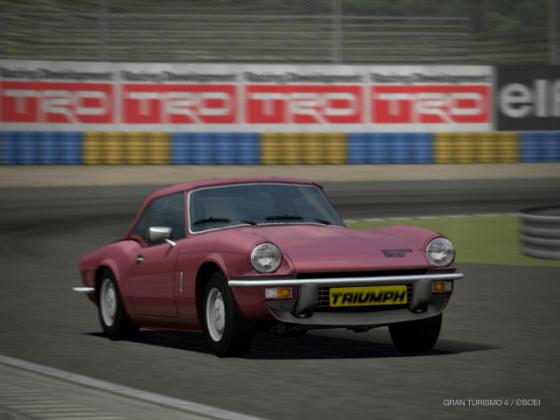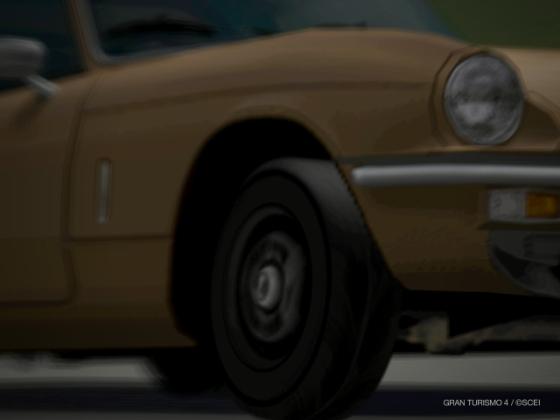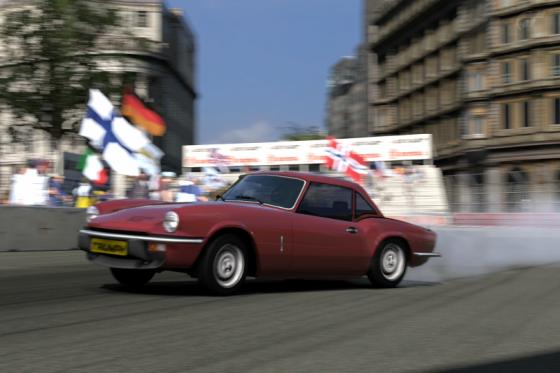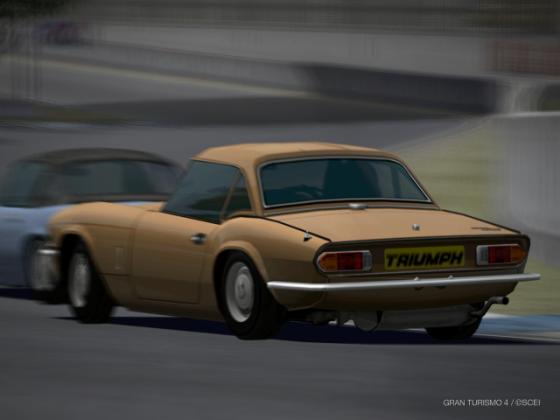|
SPEX
Year Represented: 1974
Class: Sports Car
Type: 2-seat
roadster
Country of Origin: England
Host: GT4 & GT5
GT5 Mileage: 49,651.2
Price as Tested: $17,200 (GT4), $16,249 (GT5
used car lot)
Length: 148.8" // Width: 58.6" // Height: 45.75"
Wheelbase: 83.0"
Overhang: 5 feet 10 inches
Track:
49.0" [F] 50.0" [R]
Ground Clearance: 4.65"
Construction: steel body on steel frame
Weight: 1,783 pounds
Drag
Coefficient: 0.42
Steering: unassisted rack & pinion
Skidpad: 0.87g
Layout: front engine / rear drive
Tires: 155/SR-13
F. Suspension: wishbones / coils / anti-roll
bar
R. Suspension: transverse leafs / swing axle
Brakes: solid discs [F] drums [R]
*GT5 test car received
oil change and engine rebuild for all specs & testing below
Engine: 1.5 liter OHV inline 4
Construction: iron block & heads
Aspiration: natural
Fuel System: 2 su carbs
Valves / Cyl: 2
Bore x Stroke:
2.90 x 3.40"
Compression: 9.0:1
`````````````````````````GT4````````````````````````````````GT5```````
Final BHP: 75 @ 5,500
rpm 73 @ 5,500
Fnl Torque: 86
@ 3,000 rpm 83 @ 3,000
Lbs.
per HP: 23.77
24.42
HP per Liter: 50.0
48.2
Credits / HP: $229.33
$222.59
GT4 Idle: 550 /// Redline: 6,000 /// RPM Limit: 6,500
GT5 Idle: 750 /// Redline: 6,000 /// RPM Limit: 6,500
Transmission:
4-speed manual
````````````````````GT4``````````````````````````````````GT5````````
0-60 mph: 14.950 seconds
14.834
0-100mph: 43.800 seconds
46.094
400 M: 20.216 @ 71 mph
20.251 @ 71 mph
1 KM: 36.318 @ 93 mph 36.534
@ 92 mph
1 Mile: no test
50.439 @ 102 mph
100-zero mph: 4.90 seconds
Test Track: N/A
1:23.043 (Daytona)
Top Gear RPM @ 60 mph: 3,500 rpm
Top Speed at Redline
1st: 28 mph
2nd: 46 mph
3rd: 74 mph
4th: 110.2 mph @ 6,500 rpm (GT4,
aerodynamically limited)
108.6 mph @ 6,500 rpm (GT5, aerodynamically
limited)

--------------EXTERIOR/ HISTORY---------------
I <3 Gran Turismo 4. :-) I remember a couple years back, exploring GT2, eventually driving the
Lotus S4 and writing about it. At the time, I was dismayed that this car (and an earlier S2) are the only "true" sprite-roadsters
from this game. Where were the MGs? the Triumphs? the Alfa Romeos? The Fiats? Well, this has changed a bit.
Those
of you who have bought all five GT games up till now should know that the 2nd, 4th, and 5th editions are virtual "encyclopedias"
in comparison to the 1st and 3rd. To me, GT3 was a bit of a disappointment, as it was for many others. After cruising
in several dozen classic cars in GT2, GT3 felt lacking. Off the top of my head, I can only think of three classics
from the 3rd Gran Turismo: a couple Ford GT40's (Mk III road car and the Gulf racing car), and the Shelby Cobra. The Mini
from this game has classic lines, yet represents a later model produced in the '90s. If there are any other classics here,
I'm sorry to say I'm drawing a blank.
So I got real psyched with GT4; and here's my first classic from this giant:
the Triumph Spitfire 1500, which was originally codenamed the "Bomb" before production. The word "Spitfire"
was chosen instead -- derived from the famous WWII Spitfire airplanes. Here's what we can learn from this near-forgotten nymph
of a car.
Firstly, there were five main evolutions of the Spitfire: MK1, MK II, MK III, MK IV, and the 1500. Austin-Healy
is often credited for starting it all, however. In the early sixties, Austin-Healy presented their Sprite. There were doubts
about how well a 2-seater would sell at a time when England was having its own personal baby-boom, but the Sprite did well;
prompting other car-makers to jump into the game. Triumph did so (obviously) with their lovely Spitfire. Not only did the
car sell several tens of thousand units in its first two years of production, but it was praised by some as being better
than the Sprite.
The Bomb/Spitfire might have never seen production if it weren't for lorry-maker Leyland,
who bought Standard-Triumph early in 1960. As many of us know, Leyland (later British Leyland) took over many companies, snatching
them up one by one before they could fall into receivership. Later on during the '70s and '80s, British Leyland made a slew
of poor decisions so far as car-making goes, but these early efforts of saving small, in-the-red companies like Triumph
were certainly noble. Like I said, otherwise perhaps we'd never have seen the Spitfire.
Apparently, when Leyland fully took
over Standard-Triumph in spring of 1961, one of Leyland's executives noticed one of Triumph's Bomb prototypes sitting under
a dusty cover, and asked what it was. Triumph's employees had brushed aside the Bomb "project" when they were having
financial troubles the year before, but now Leyland was showing interest in the little car. Good for them, eh?
The
Spitfire body was actually built on the frame of another Triumph (the Herald)...a bit of early cost-saving that helped them
turn early profits, but was this a good idea in the long run? From year to year, better features were added: a heater
became standard in later versions, the interior was upgraded from rubber and plastic to wood-grain and chrome parts, and in
the late '60s, an overdrive transmission became standard. Still, there were many faults with the Spitfire, which I'll
discuss later. Or if you opt, just buy one and take a spin. This will save you having to read the rest of this review. :-)
In
the game, this car (the Spitfire) is just as cute as can be, and promises good times for many. Okay, for some.
There are many colors to choose from: classic British green to topaz to silvers, blues and red. Oddly, there is no black Spitfire.
I only say this because for some reason I wanted a black one. Oh well. GT5 fixes this, of course, and I've got my
classic black car now.
Sports cars from the seventies (European and Japanese, mostly) were often lightweights,
and the Spitfire 1500 was no exception. At 1,783 pounds, I don't see any reason to throw more ballast
overboard, and I have yet to do so. This is a beautifully nimble machine, with many merits. But some work needs to be done.
Actually lots of work needs to be done. :-/ You're about to make the parts shop a few good credits, actually...
----------------ENGINE / DRIVETRAIN-----------------
Let's start with the motor.
Ohhh boy. Seems odd, don't it? Back in the day, European sports cars sure
didn't pack in the power. I mean, we're almost talking Kei car measures here, guys. 75 HORSES AFTER OIL CHANGE!!! Just over
86 pound-feet of torque? Yikes Yikes Yikes.
The 1500 engine (get ready) was actually an improvement
over the MK IV, which was produced up till 1974 and featured about 62 horses!! What was wrong back then? This improvement
was made possible by extending the piston stroke a bit, but we as Gran Turismo drivers will barely have anything to fear at
first! Trust me...the only wheelspin this baby will garner at first comes from when it's in one of its slides...more on that
later.
Fortunately, Triumph (which in the middle-70s was still owned by British Leyland) apparently had a giant
assortment of parts to raid. I say this because we can buy three NA stages or two turbos
on the after-market in GT4, or 3 NAs + 3 turbos in GT5! The steps these upgrades take seem rather small, (a Stage 1
NA tune, for instance, adds just 11 horsepower) for this light-weight situation, but the Spitfire 1500 does become
more and more threatening to some AI cars as we bolt in those kits.....
.....if you can manage to control it that is....
The
best kit we can buy for the engine in GT4 is a Stage 2 turbo, which suddenly raises lots of horses from the barn.
:) A much larger amount than the Stage 3 NA kit, oddly. Perhaps a set of new cams and lightweight pistons (Stage
3) don't help much for the Triumph engine wheras a turbo system does.
GT5 features all three turbos + the
three fixed engine kits (Stages 1, 2, and 3). Total power rates as follows:
Horses
Torque
Oil + maint: 72 @ 5,500
83 @ 3,000
Fully Tuned*: 99 @ 6,100 103
@ 3,600
Stage 1 NA: 113 @ 6,200 115
@ 3,700
Stage 2 NA: 131 @ 6,300 132
@ 3,800
Stage 3 NA: 146 @ 6,400 145 @ 3,900
Stg
1 Trbo**: 176 @ 5,100 220 @ 3,400
Stg 2 Turbo:
214 @ 4,900 236 @ 4,400
Stg 3 Turbo: 234 @ 6,400
192 @ 6,400
*= "computer", best intake + best exhaust parts
** = Stage 3 NA kit + turbo
Another
feature of interest is the 4-speed transmission. In most early racing, it is useful, but eventually it'll need to be replaced
by a full-racing gearbox since 4th gear maxes at 110 miles per hour. This is truer in GT4 than it is
in 5, though. Even at the Professional level of GT5 (during the British Lightweights) I was still using a stock tranny. An
odd sidenote here: during my track testing, the Spitfire (when fully stock) made its top speed right at its virtual
RPM limit of 6,500, yet refuses to go any faster in either game. Literally, if the engine could eke out just 1 more mile-per-hour,
the RPM limiter would shirk the speed back. This never happened during the test.
In any event, buy that last
(most expensive) gearbox. It will be a worthwhile spend. Personally, I hate the tranny whine that shows up after
giving up the stock box in GT4, but it's much more tolerable and quieter in the 5th game.
...Lest any
of you think we're done with raiding parts....

-----------CHASSIS / HANDLING-----------------
Here's where things really start to get lovely, folks, and I mean this with all my heart & soul.
GT4
After several years of
driving Miatas and S2000s around in Gran Turismo games, and then mastering TVR, I thought I had the whole roadster/sports
car game down pat. Well....
Get behind the wheel of the Spitfire. It may come as quite a shock
what we are about to experience. Even some veterans will have their hands full trying to control this car, which
oversteers constantly and with broad, jolly strokes that look downright goofy during replays; yet will make
many feel like they've just thrown back to driving school with the words "TOTAL ASS" written all over their
helmet. It's not us that's at fault, though, it's the car.
Triumph actually had a huge issue with this as they produced
the Spitfire in greater and greater numbers. Believe it or not, the Spitfire 1500 is the best they could do
after this so-called issue was addressed! Which makes me honestly frightened to try driving an early MK 1 or II version.
The
problem had to do with the original swing-axle design. Apparently, driving enthusiasts of the day found joy
in this car's swipey, oversteerish nature. As you drive around a course like Autumn Ring, you too will find yourself countersteering
literally as much as you'll be steering normally. That is not a joke. It is not an exaggeration I'm making up to
keep your attention as you read this reveiw. Yes it's cool once the driver finally masters the soap-bubble nature
of this machine, but to get serious, please read on.
A 1-way or 1.5-way differential will
work wonders. Literally. Now add a sports suspension. All of a sudden, lap times will decrease by
huge seconds. Acres of countersteer necessary to correct the car before improvements become casual
flicks of the steering afterwards. Fishtailing? GONE. Oversteer? Where did it go??
The 1500 starts to understeer
a bit, but when really pushed, the rear will still step out a tad as well--which of course is desireable in a sports
car, anyways.
S3 sports tires...stronger drivetrain parts and brakes... Keep upgrading. The nimbleness will still be
there minus all the bad stuff. Now we're on our way...taking the Spitfire from being a dreadful bowl of English porridge to
a fine death ray, one of the most complete transformations I've experienced in a GT game without a race-kit.
GT5
And....Wow...what a difference.
GONE is much of the crappy handling of GT4. Yes, the Spitfire 1500 still oversteers constantly, yes its tail is often
swinging out a bit, but it also oversteers now much more pleasantly. It is so much easier to control
in this game. Understeer (which wasn't that great in GT4) is still easy to eliminate and work with if it does show up, but
that's not all.
"Wait, forget the understeer, what happened to all that oversteer?" you
are asking. Easy.
Often a small flick of countersteer is all that's needed if the car's
rear is getting sideways, power is low, and that's on its stock "Comfort Medium" grade tires. Contrast this
to the KILOWATTS of energy used just to control the car as it appeared in that prior game. The broken dual-shock steering
mushrooms. The agony. The laughter from your imaginary pit crew.
All in all, the same car as it appears in GT5 is
just pure fun. And that's without a limited-slip. Without a Sport suspension. Without any additional
"help", settings, or tuning. As power gets added (like for the FR Challenge and Pro-level British Lightweight Series, perhaps),
some of these extra parts will definitely need to be employed. But for the easier stuff...the Sunday Cup, the World Compact
Car Series, the European Classic Car Challenge, the Spitfire can now play the role of its original codename: Bomb.
For some of the Ai in these races may feel as if they've just been hit with a bomb after you destroy them in those
corners!
Granted, there are still a few things to watch for. Braking is rather mushy if
you're like me and refuse to use ABS and/or the Brake Controller settings on a 37-year old car. Mushy, but effective.
This is one of the best non-ABS types I have driven, to be honest. You just gotta start braking a bit early,
of course. Trail-braking from any speed over 60 mph (sometimes less) also requires extreme care, for the Spitfire can easily
get into a slide or a spin if one gets too eager! And the thing is, you may find yourself tempted to trail-brake too strongly.
To just chuck the car into a corner. That's because the Spitfire often acts like it wants to be chucked! Sometimes,
this is actually desireable, to just say "chuck it! ;-)
Ever drifted a 70 horsepower car? Now, in GT5, you certainly
can. :D You might wanna do so by forcing it sideways. But for those who are trying very hard not to have any of this happen,
you will need to concentrate. Maybe not as hard as you did during GT4, but the Spitfire is still difficult.
Also,
even with the GT5 car's improved handling, some less-experienced drivers might just want to get an easier-going car. The Spitfire
is easier to work with in GT5, but it's still likely a handful for some. My first test car, for instance, only had
about 6,900 miles on its odometer, yet felt very flimsy...more like a car with 200,000 miles! It's easier to control
than in 4, very true, but it's also constantly still letting you know it still wants to play. Getting loose in turns.
Bouncing and losing its stability (what stability it has, anyways) over curbs a heavier car would soak. Stuff like that.
Bottom line: you may think you're just here to win a race. The SPITFIRE on the other hand, still thinks its about
to have a bit of play-time. It's like that dog which has been waiting for its master all day. Master comes home, the dog starts
jumping all over the room! Heel, Spitfire! Sit! Stay!!!
And of course, once power is being thrown about
during our faster races, that's when the tuning starts! If you haven't got your tuning...uh...fine-tuned,
if you aren't adept at finding ways to minimize the oversteer that WILL return from GT4 if power is seriously raised, it's
probably best recommended you go back to that trusty Miata roadster! On the other hand, once I got some mild LSD
and height-adjustable sport suspension settings dialed in during the ferocious British Lightweights, I found the Spitfire
very controllable; and rating a 10 out of 10 on the 'fun-ness' scale.

PROS
1). Let's start with that putt-putt engine idle. That's
really yummy.
2). And that buggish bodywork, designed by Italian master Michelotti. Gran Turismo doesn't slack here
and even includes the eccentric passenger-side only mirror, as well as a giant barrel of a muffler under the boot.
...Oops...I
meant driver's-side mirror. Damn right-hand drive cars!
3). Engine upgrades (turbo and naturally-aspirated) available
in GT4 and GT5.
4). Lightweight steel rusted too fast in real-life but is a huge bonus in the game. Weight reductions
are sometimes a bad idea.
5). Nimble as can be, light on its toes, and a virtual devil once you get the hang of it.
In GT5 especially, a controllable drift is almost always under your command.
6). Lots and lots of colors available
from Triumph.
7). Nice price for a classic. The original sold for just $2,900 by the way.
8). Like the Mini,
a Spitfire is tiny as can be. At times you can pass thru keyhole-size gaps left between the AI to get ahead.
9). GT5
mostly: one hell of a lot of fun to drive! And that's with zero tuning and stock tires, too.
CONS
1). Obvious. Extrememly dangerous handling at the limit (WHAT
limit?) Oversteer galore. So much rear-end iffy-ness, you'll be astounded Triumph managed to safely sell any Spitfires at
all. And it's not even RAINING yet in my game. All of this is true in GT4 while the car is still stock. In GT5, it mostly
becomes truer with lots more power.
2). And there's the lack of power to start with. It's hard to believe sports cars
once featured such a lack of go, yet many of them did. Triumph (or even Great Britain) is not solely to blame.
3).
Even with the right parts and settings, most of the driving is still left to the driver to get it all down. Of course, some
of us see this as a Pro, not a Con.
4). Top speed ceiling limited by a short-geared 4-speed. Full-custom gears eventually
needed. Triumph may have figured most of their customers should NOT try and get this machine over 110 mph.
5). Poor
stability over grids, curbs, and grass. This lightweight can be easily upset by larger AI cars, too.
6). Poor acceleration.
As power gets raised this of course improves, but shifty handling returns as well. Which means more money needs to be spent
on some pricier suspension & brake parts.
7). GT4: Stage 3 NA tuning. At $65,000, we get about 40 hp less
than a Stage 2 turbo would provide. And the turbo system costs tens of thousands less.
8). Tricky trail-braking action.
Originally Published: April 7th, 2007
Edited for GT5 content: once in 2011, again on Nov. 25, 2012

|